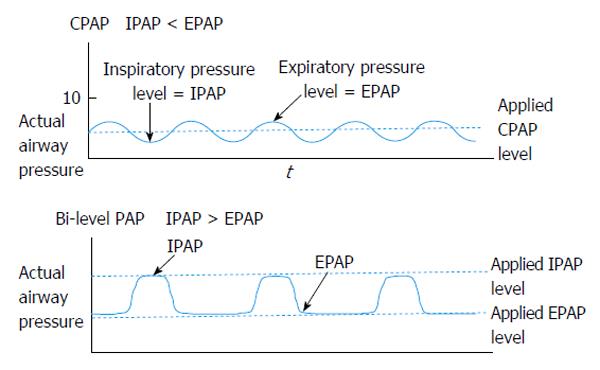Copyright
©2014 Baishideng Publishing Group Inc.
World J Cardiol. Nov 26, 2014; 6(11): 1175-1191
Published online Nov 26, 2014. doi: 10.4330/wjc.v6.i11.1175
Published online Nov 26, 2014. doi: 10.4330/wjc.v6.i11.1175
Figure 5 Differences in actual airway pressure between continuous positive airway pressure and bi-level positive airway pressure.
While on CPAP, although a constant CPAP level is applied, actual airway pressure is not constant and oscillates. During inspiration, actual airway pressure decreases below the applied CPAP level, whereas during expiration, actual airway pressure increases above the applied CPAP level. Thus, the inspiratory pressure level in the airway (i.e., IPAP) is lower than the expiratory pressure level in the airway (i.e., EPAP). Conversely, while on bi-level PAP, the actual airway pressure increases during inspiration due to pressure support. Thus, IPAP is greater than EPAP according to the level of pressure support. CPAP: Continuous positive airway pressure; EPAP: Expiratory positive airway pressure; IPAP: Inspiratory positive airway pressure; PAP: Positive airway pressure.
- Citation: Kato T, Suda S, Kasai T. Positive airway pressure therapy for heart failure. World J Cardiol 2014; 6(11): 1175-1191
- URL: https://www.wjgnet.com/1949-8462/full/v6/i11/1175.htm
- DOI: https://dx.doi.org/10.4330/wjc.v6.i11.1175









